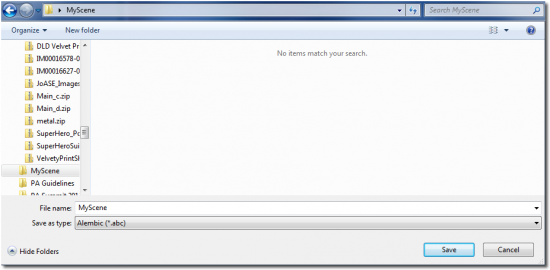Sidebar
Alembic Exporter
Introduction
The Alembic format is used in production pipelines involving many of the top 3D modeling/animation applications. With this exporter plugin for DAZ Studio you gain the ability to move small to large file assets, as well as “Vertex Exact” animations, from DAZ Studio to your favorite 3D modeling/animation applications.
Process Overview
This document will guide you, step by step, through installing and exporting using the Alembic Exporter.
Foundation
In order to use the Alembic Exporter for DAZ Studio, you need to have DAZ Studio 4.6.1.39 or newer installed on your system. You should have a good working knowledge of DAZ Studio and be comfortable with exporting. You will need to have a working knowledge of your target 3D modeling/animation application, as we do not cover the import process of the target application here. Please see the respective importer documentation for further help in this regard.
Installation
It is recommended that you use DAZ Install Manager to install Alembic Exporter for DAZ Studio. This will ensure that the plugin files are dropped into the proper locations within the DAZ Studio folder/file structure.
Once installed, you should see “Alembic (*.abc)” as a new option in the list of available formats in the Export File dialog.
Process
The following steps will walk you through the entire process. At the end, we have included a few notes and usage tips.
Let's begin!
Step 1 – Set up Your Scene
The first thing you need to do is open DAZ Studio and load or create a scene. This can consist of a single static figure or a complete scene with animation. The Alembic Exporter is capable of working with very large files, so you are not limited in size.
Step 2 – Export With Alembic
Next we want to export our scene using the Alembic export option.
- Select “File > Export”
- Choose a location and name your file.
Step 3 – Alembic Options
At this point, you will have the following options to choose from:

- Only Visible Objects – When selected, only objects which are “visible” will be exported. Any hidden objects will be ignored.
- Include Vertex Animation – Selecting this option will export the full range of frames you have set up for animation. When left unchecked, it will export the current frame only.
- Preserve SubDivision Surfaces – If you would like the mesh to look exactly like it does in DAZ Studio, leave this option unchecked. This will ensure that the mesh exports exactly as you see it. If you would like your target application to handle the SubDivision Surfaces, then you will want to make sure this option is checked. The mesh will then be exported as a SubD cage, thus allowing your 3D modeling/animation application to make the calculations for SubDivision surfaces. (This also results in smaller file sizes.)
For LightWave 11.6.1 you must make sure the Preserve SubDivision Surfaces box is left unchecked. If you leave it checked, no geometry will be imported.
- Collect Textures – The Alembic format does not preserve your materials or textures. You will need to manually re-apply the textures and make any adjustments to settings in your chosen 3D modeling/animation application. By selecting this option, the exporter will collect all of the used textures in one organized location, which will make them easier to find and associate in the target application.
Now, you are ready to import into any program that imports the Alembic format. Please refer to your chosen application's documentation for import options and instruction.
Things to Remember
Here are some things things to remember when choosing the Alembic export option:
- Alembic is very fast. Both the export and import [by other applications] are quicker than most other options.
- Alembic can deal with huge file sizes. This is an advantage over trying to merge several smaller bits and pieces together due to size limitations of other options.
- Alembic is “Vertex Exact“. It brings in the exact vertices exported from DAZ Studio, and as a result, your “animation” will look exactly the same in your chosen 3D modeling/animation application as it does in DAZ Studio. Think of this as a combination of OBJ + MDD.
- Alembic gives you two options for mesh export. You have the option to export an exact mesh, or allow your chosen 3D modeling/animation application to calculate the SubDivision on a preserved SubD cage. The option for preserving SubDivision Surfaces will result in smaller file sizes as well.
- Alembic allows you to collect texture maps in one concise location. While material and texture definitions are not included in the export, all materials retain their names and can be applied manually. This is easier to do if you choose to “Collect Textures”.
Wrap-Up
This document is intended to help you through the basics of exporting one of the top new formats used in production pipelines involving the leading 3D modeling/animation applications on the market. We hope that providing new cutting edge options will allow you to use DAZ Studio more readily and easily in your pipeline.


